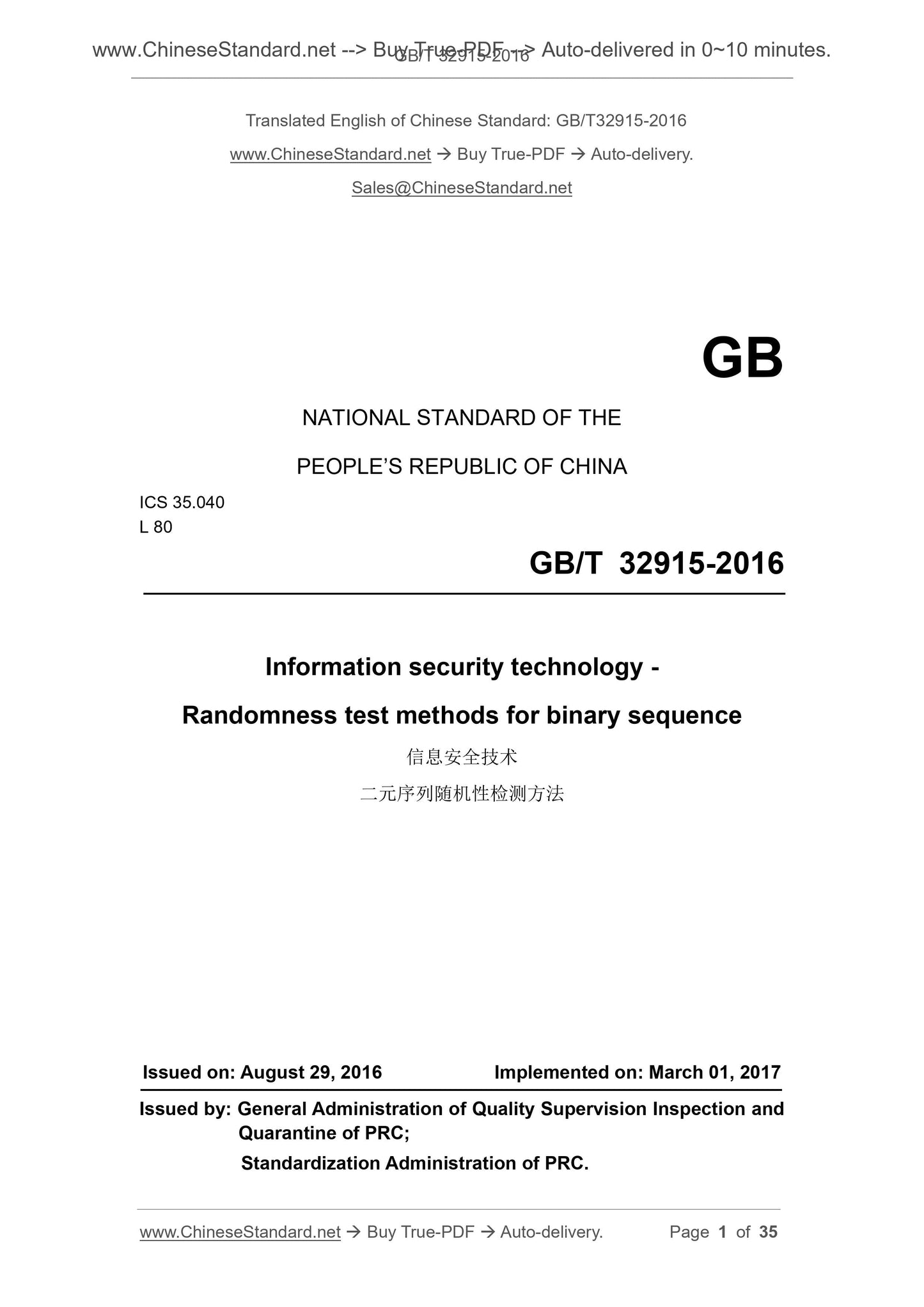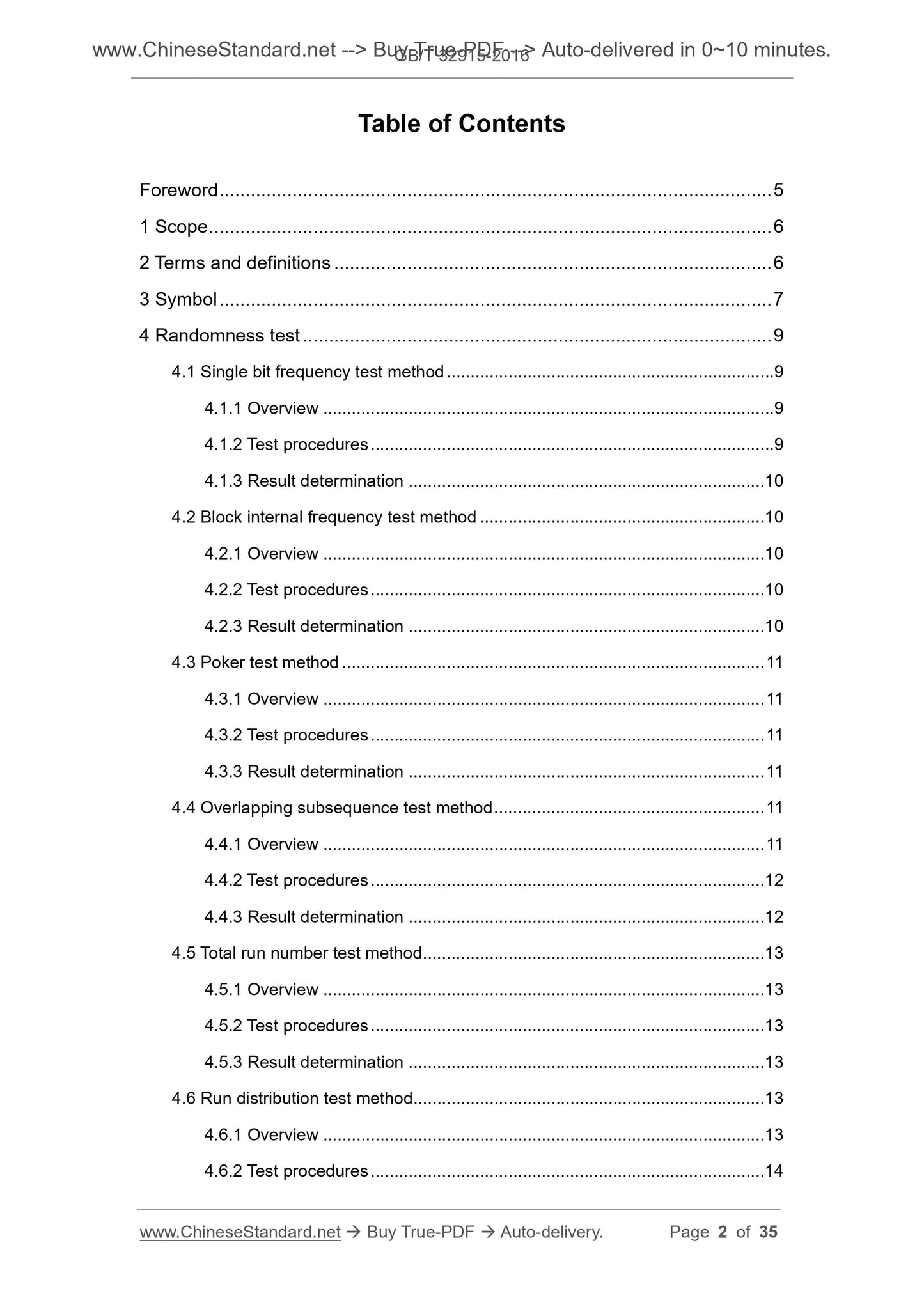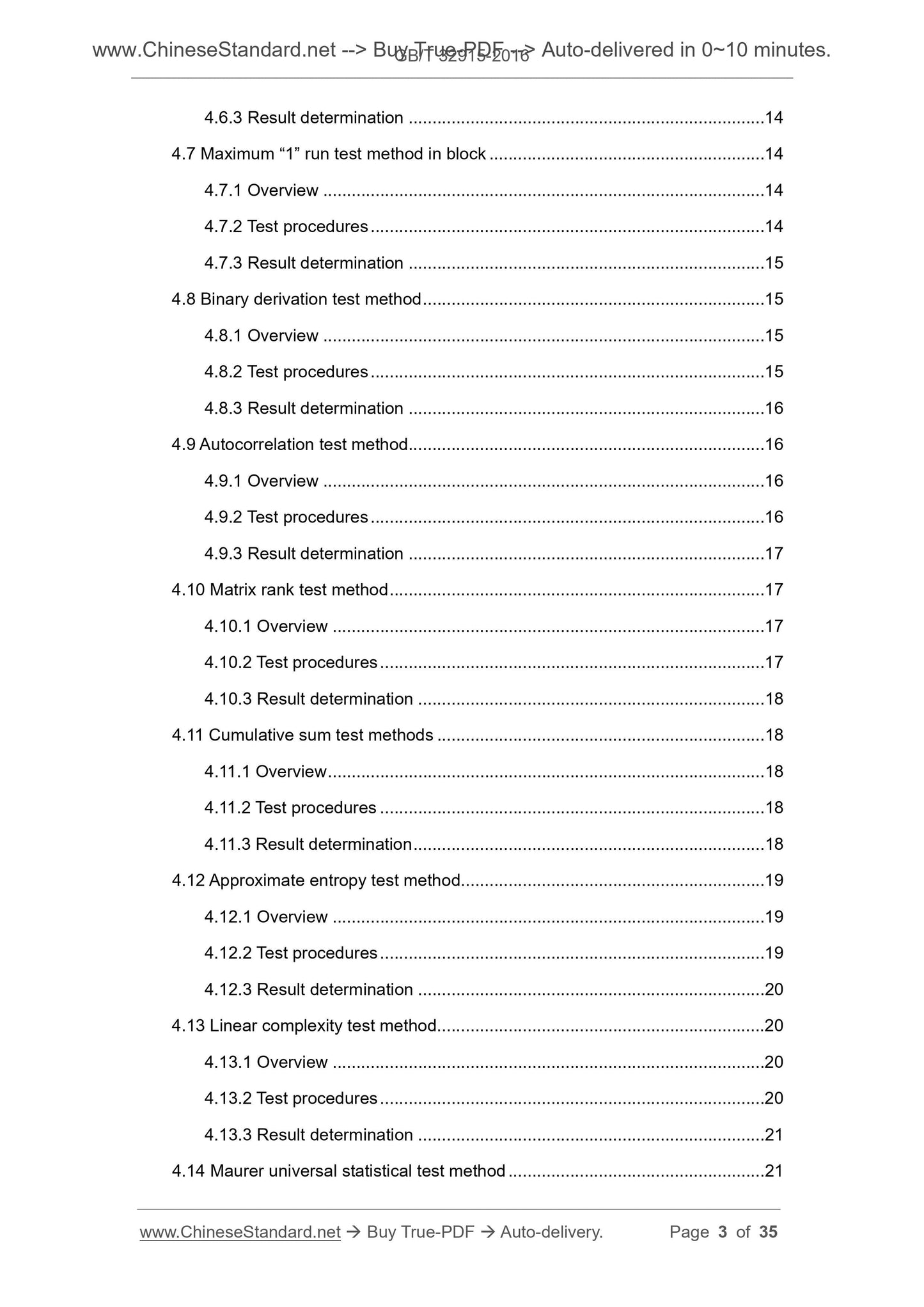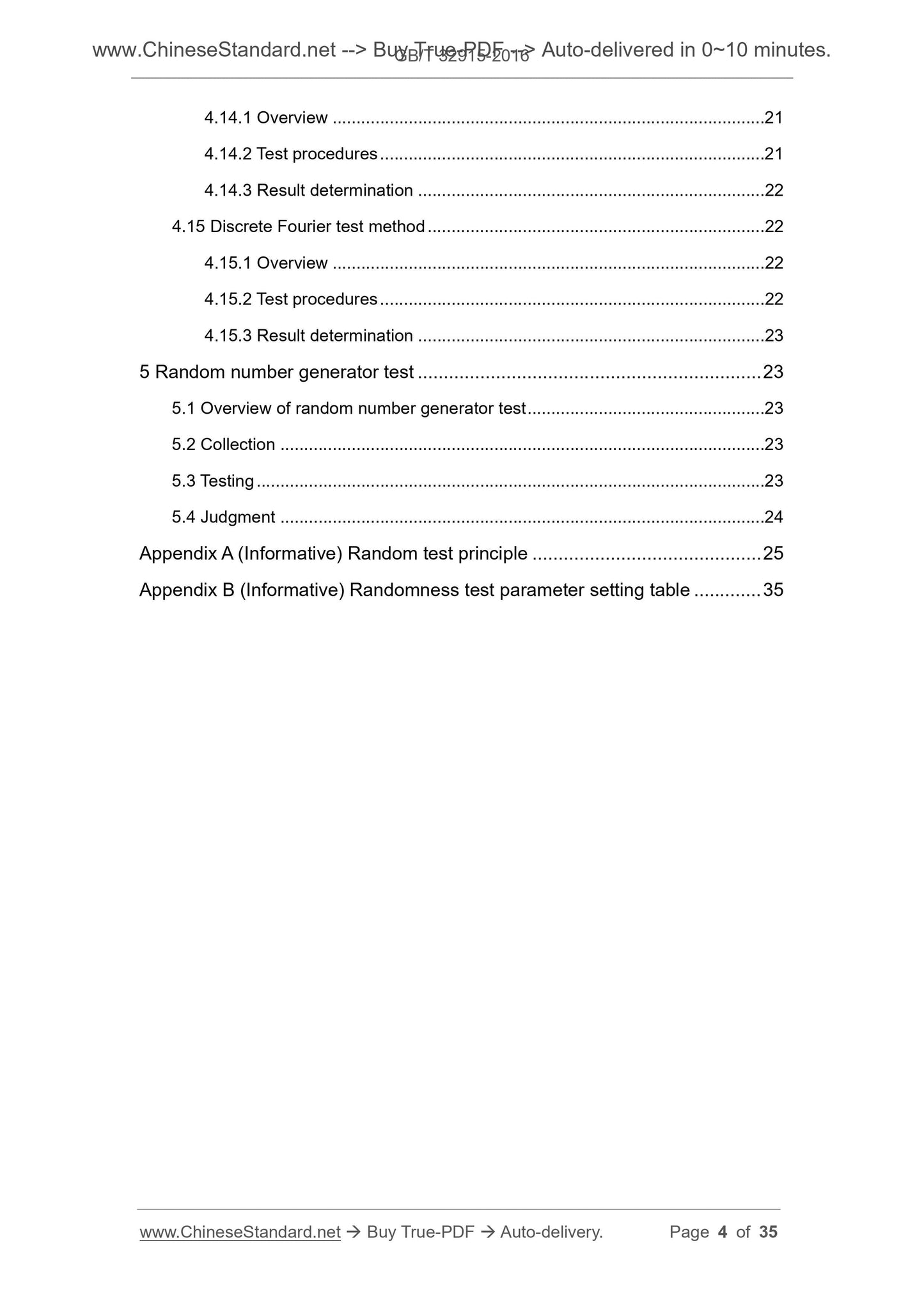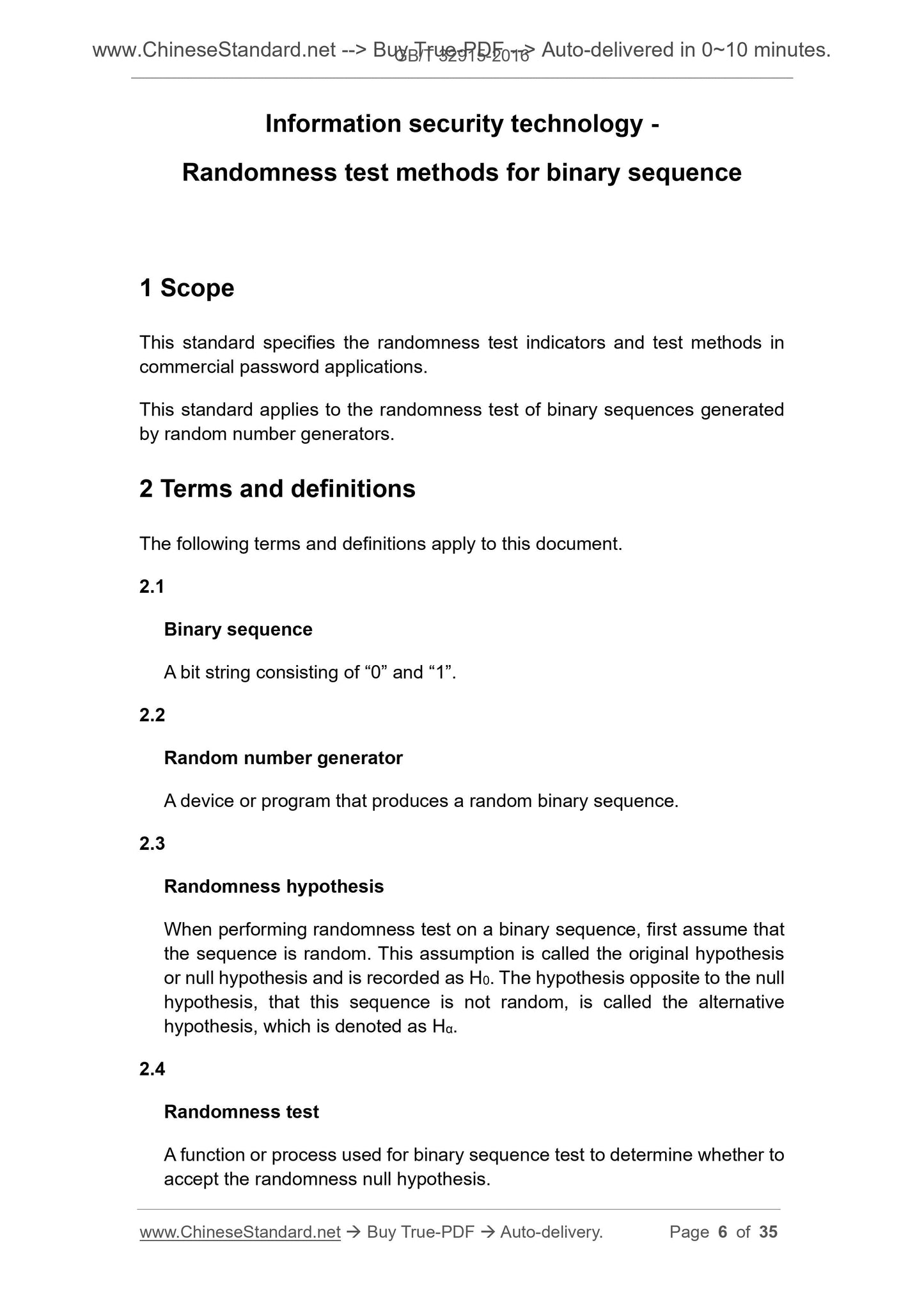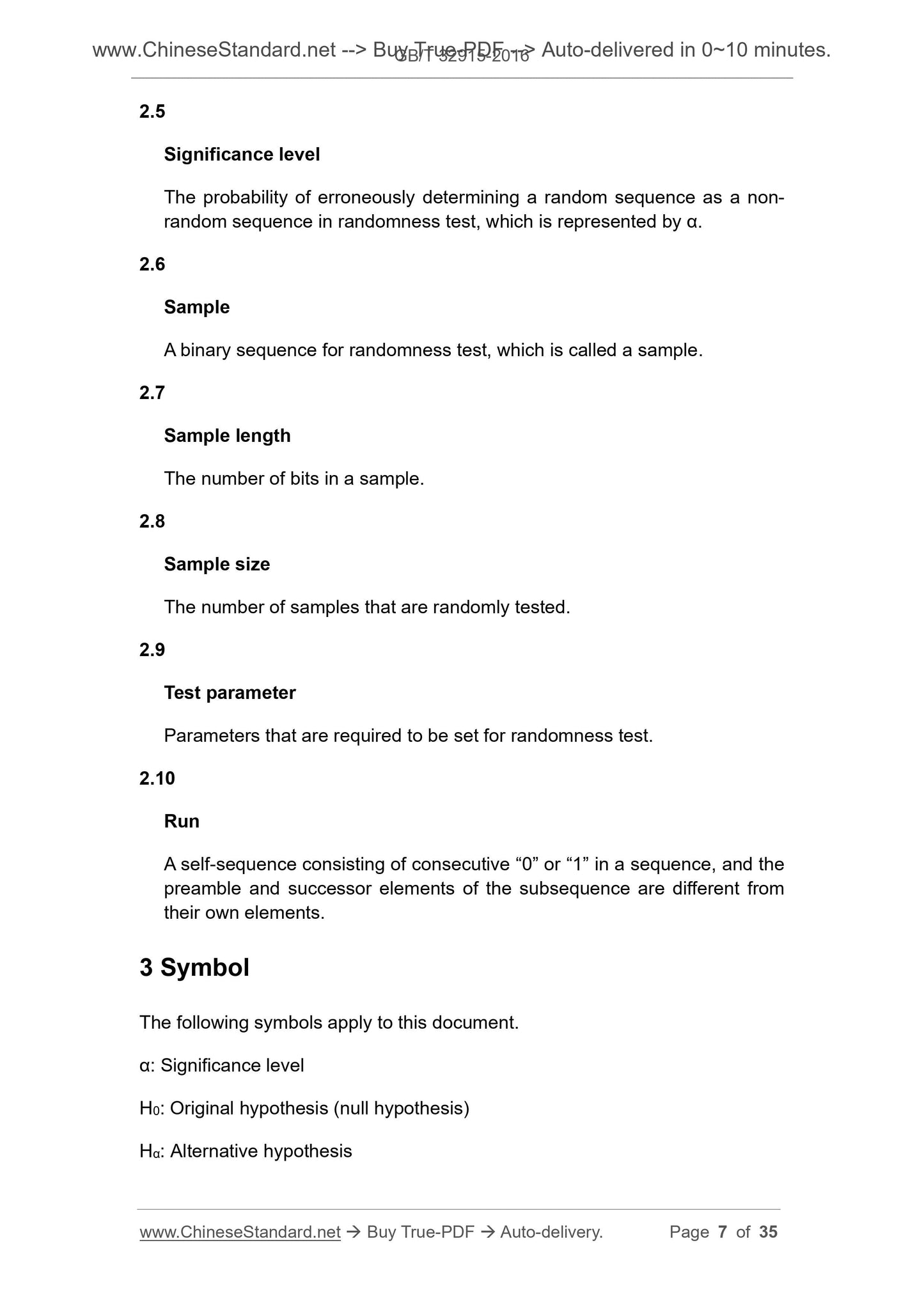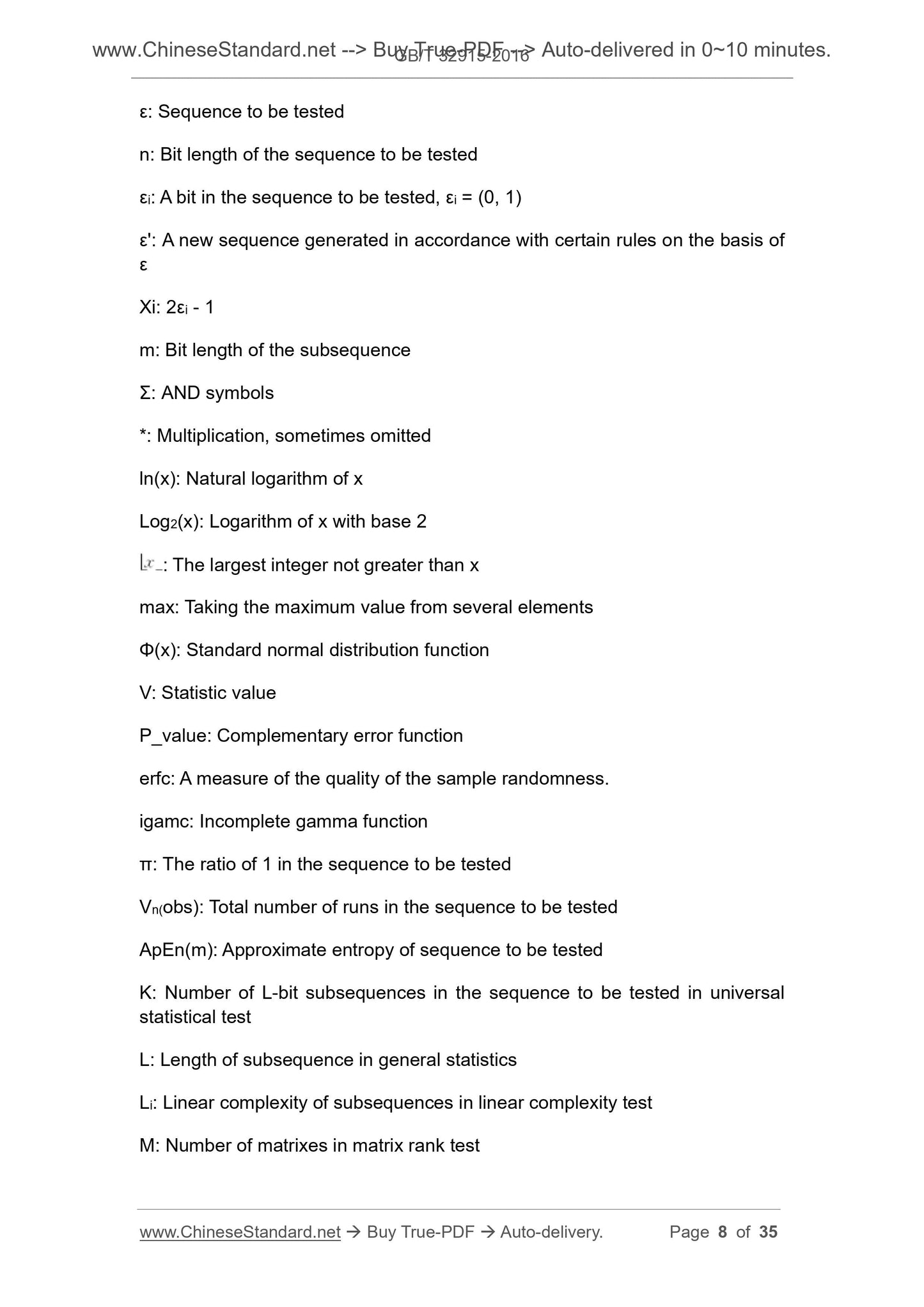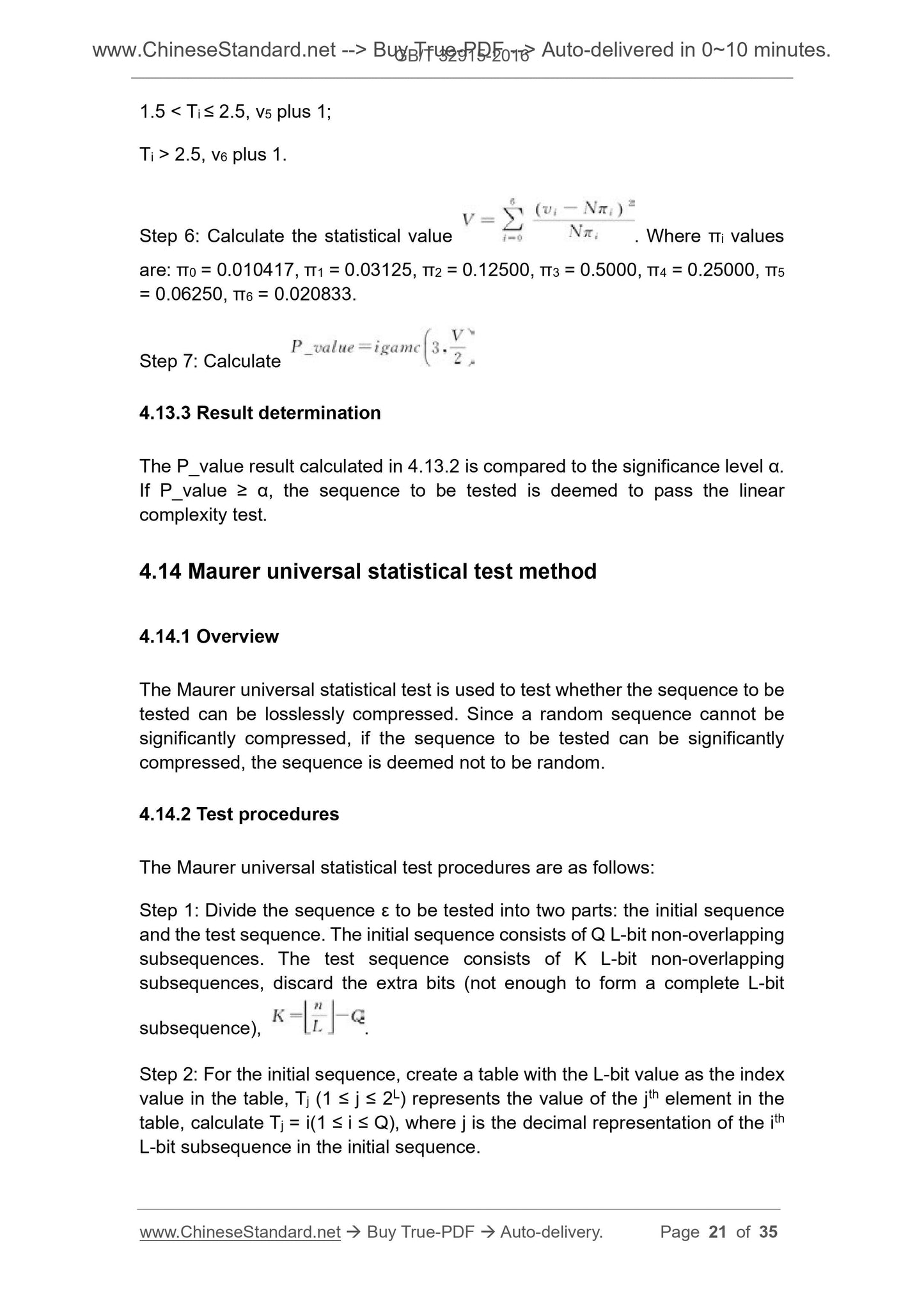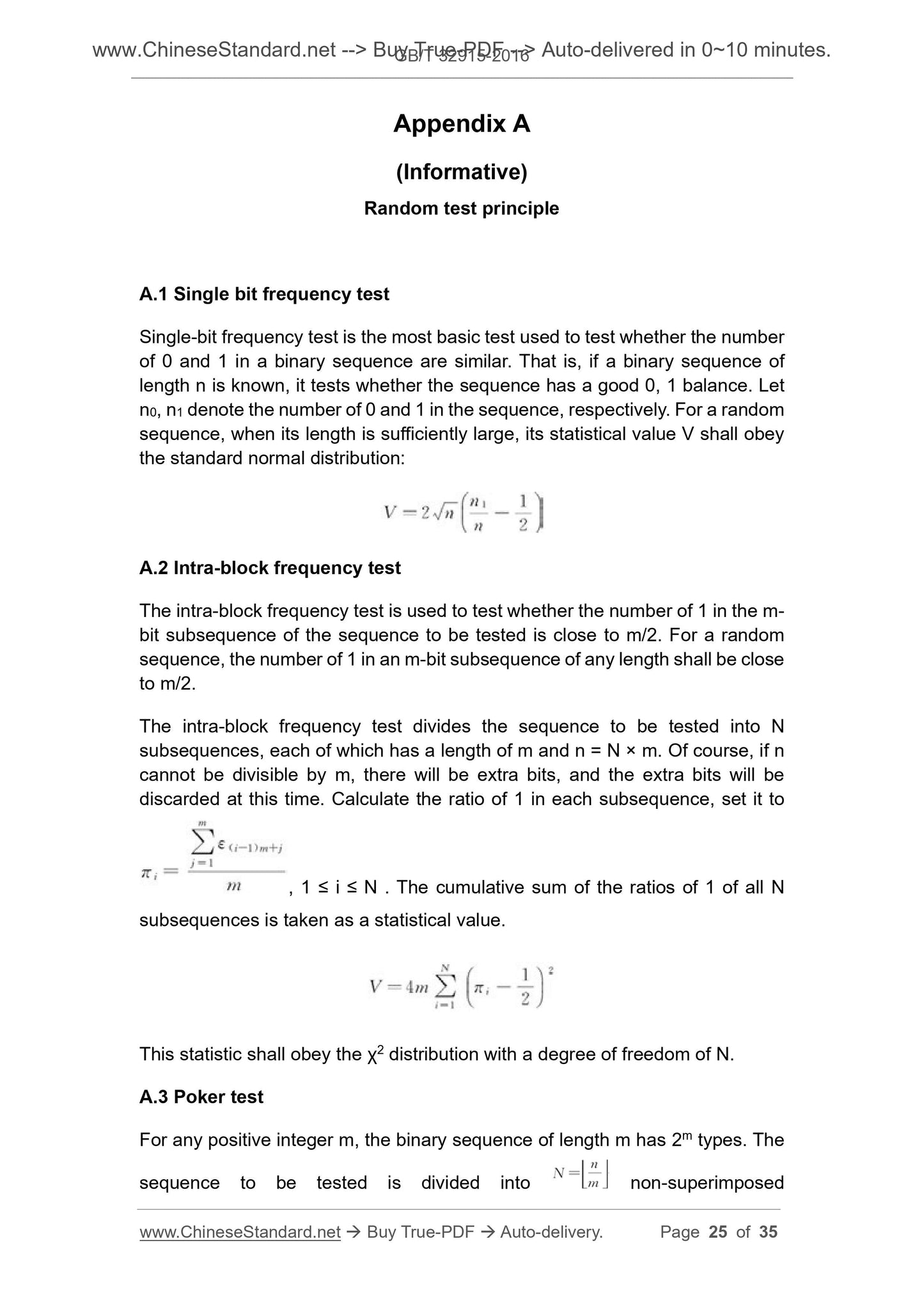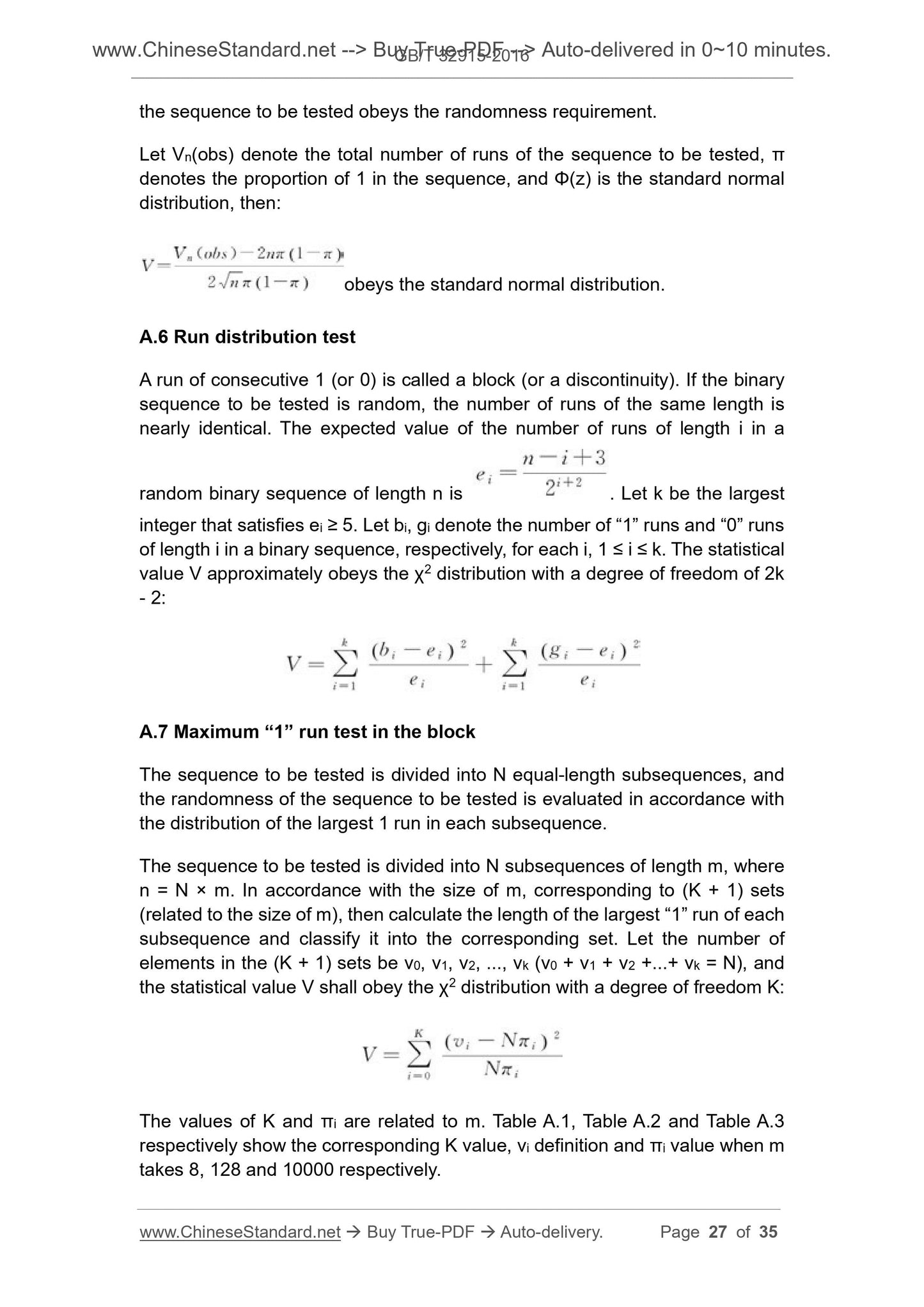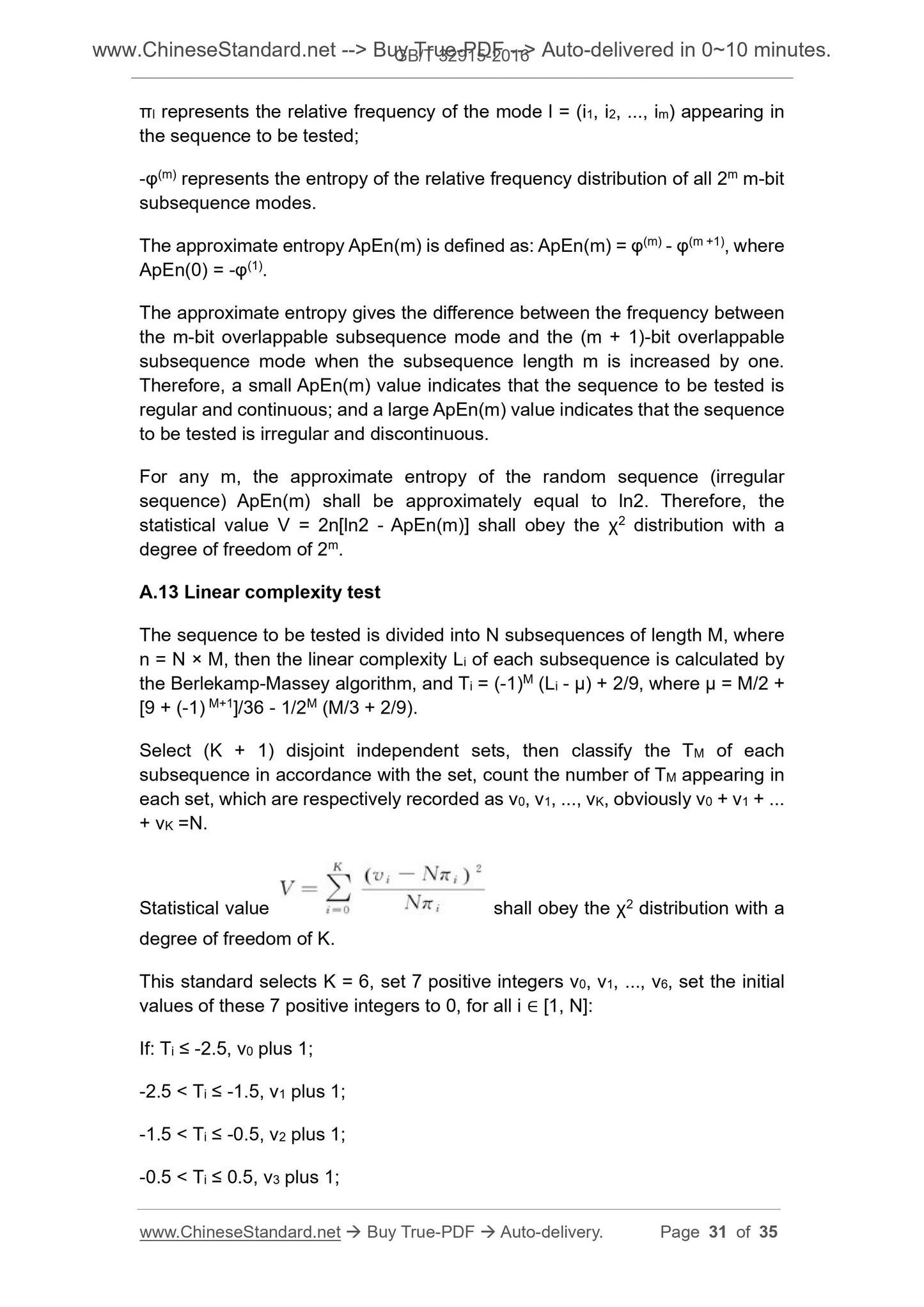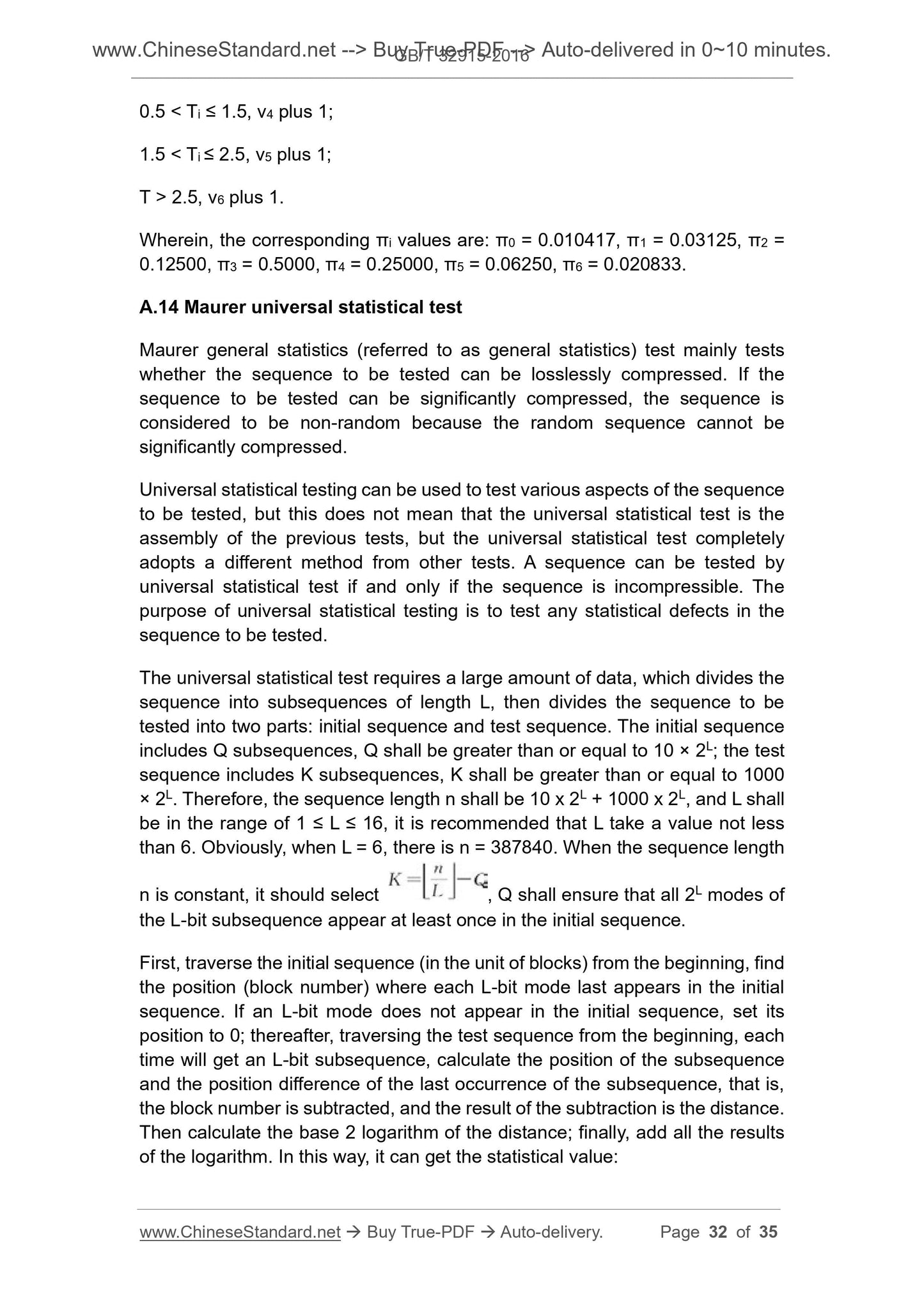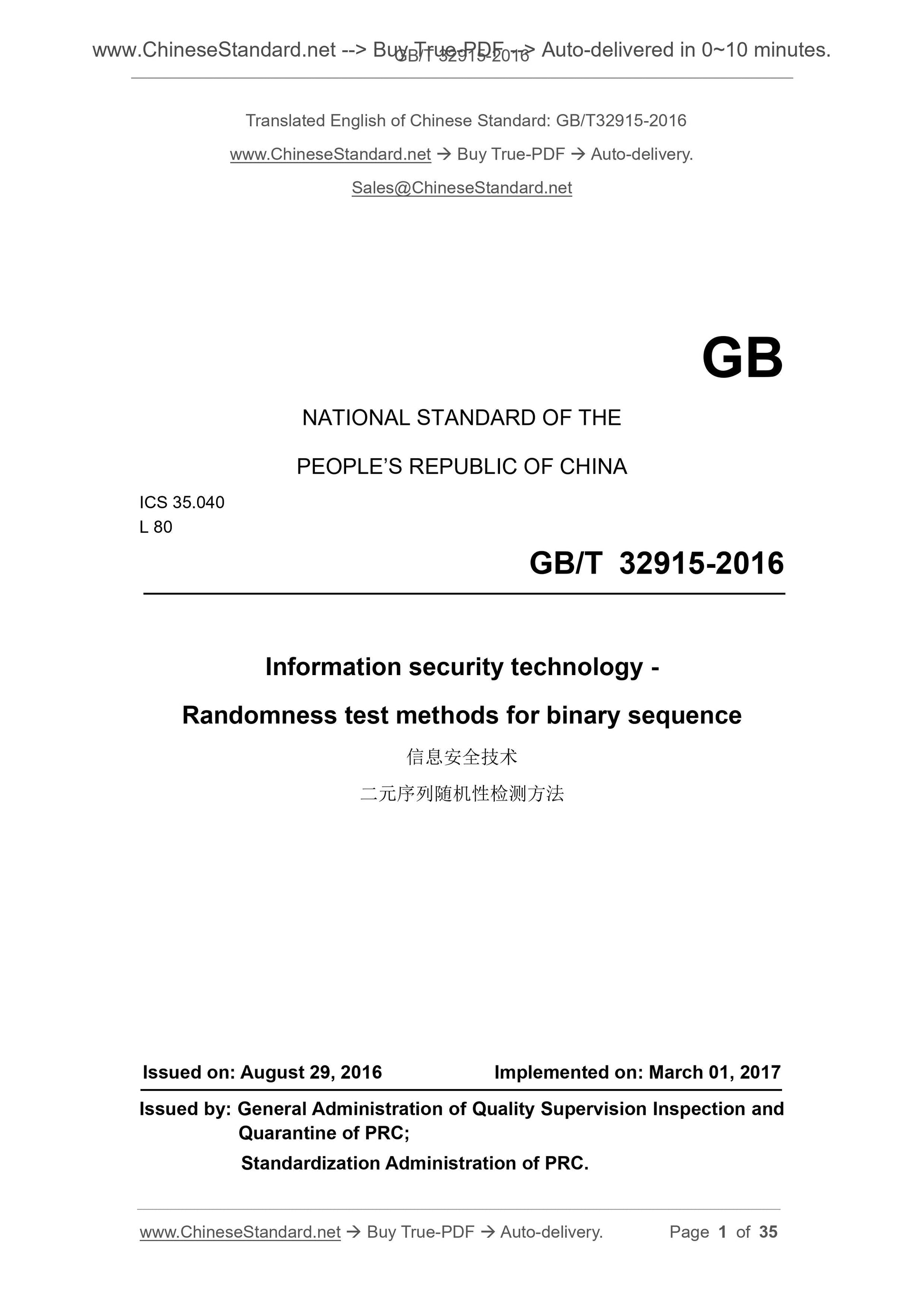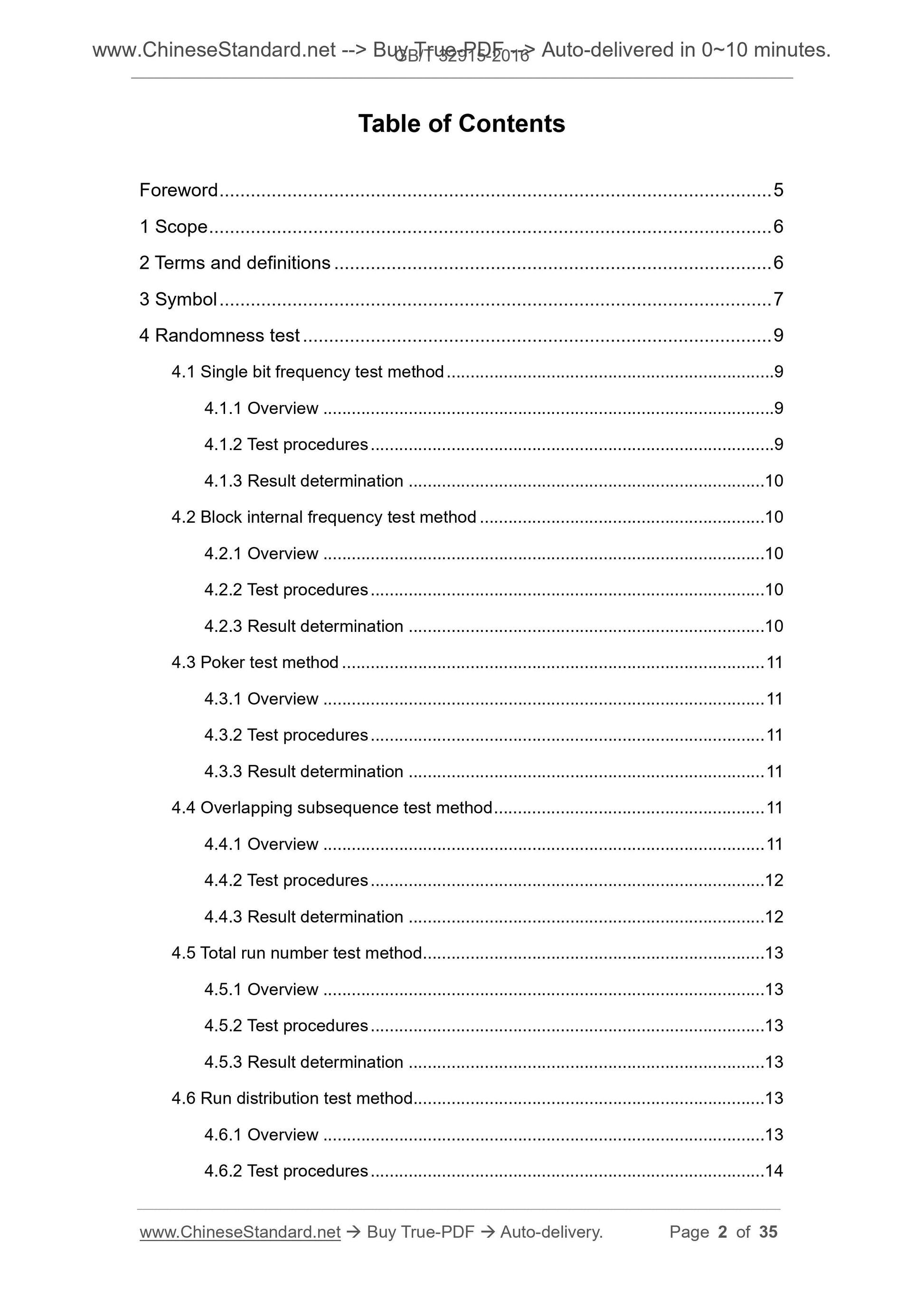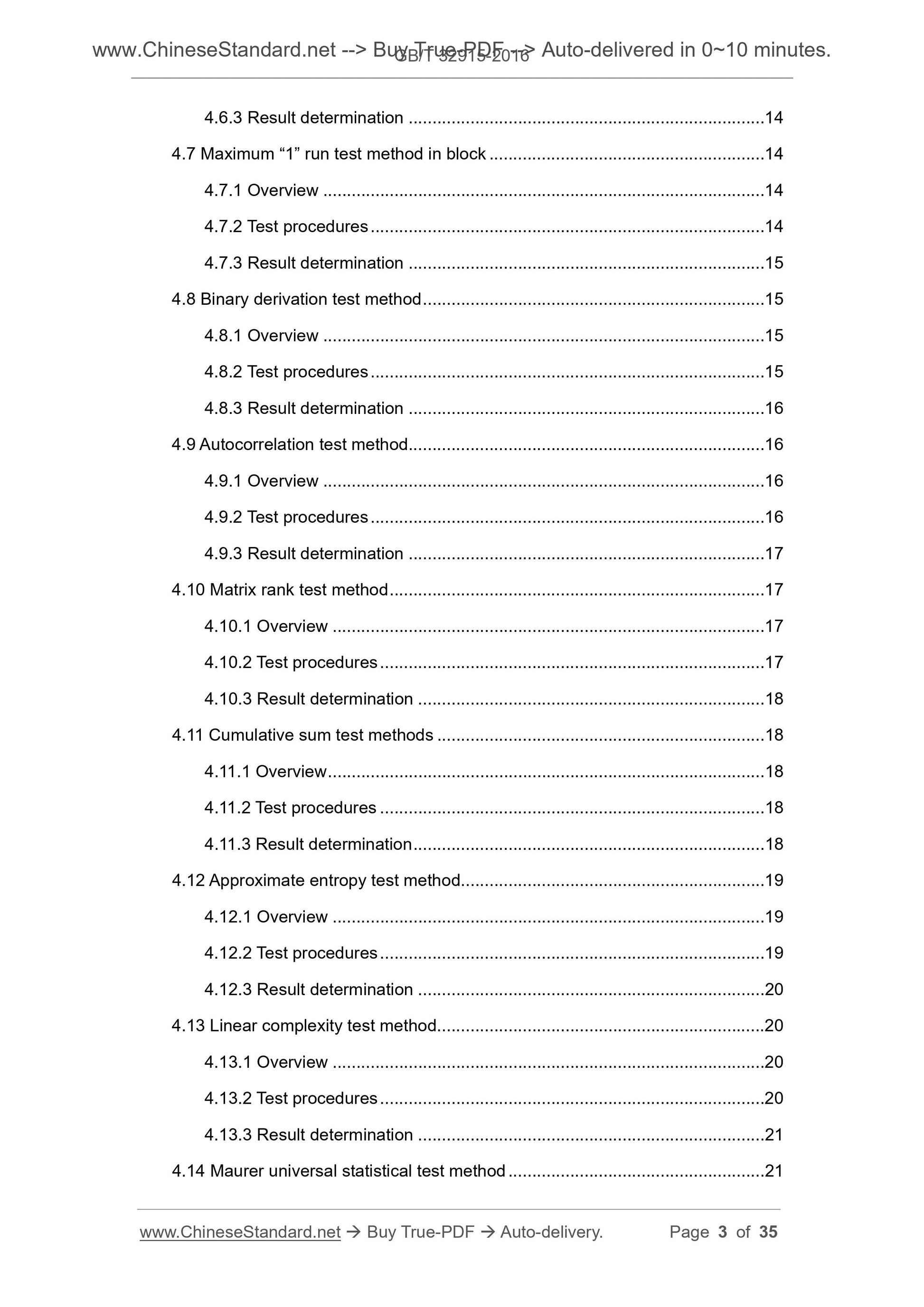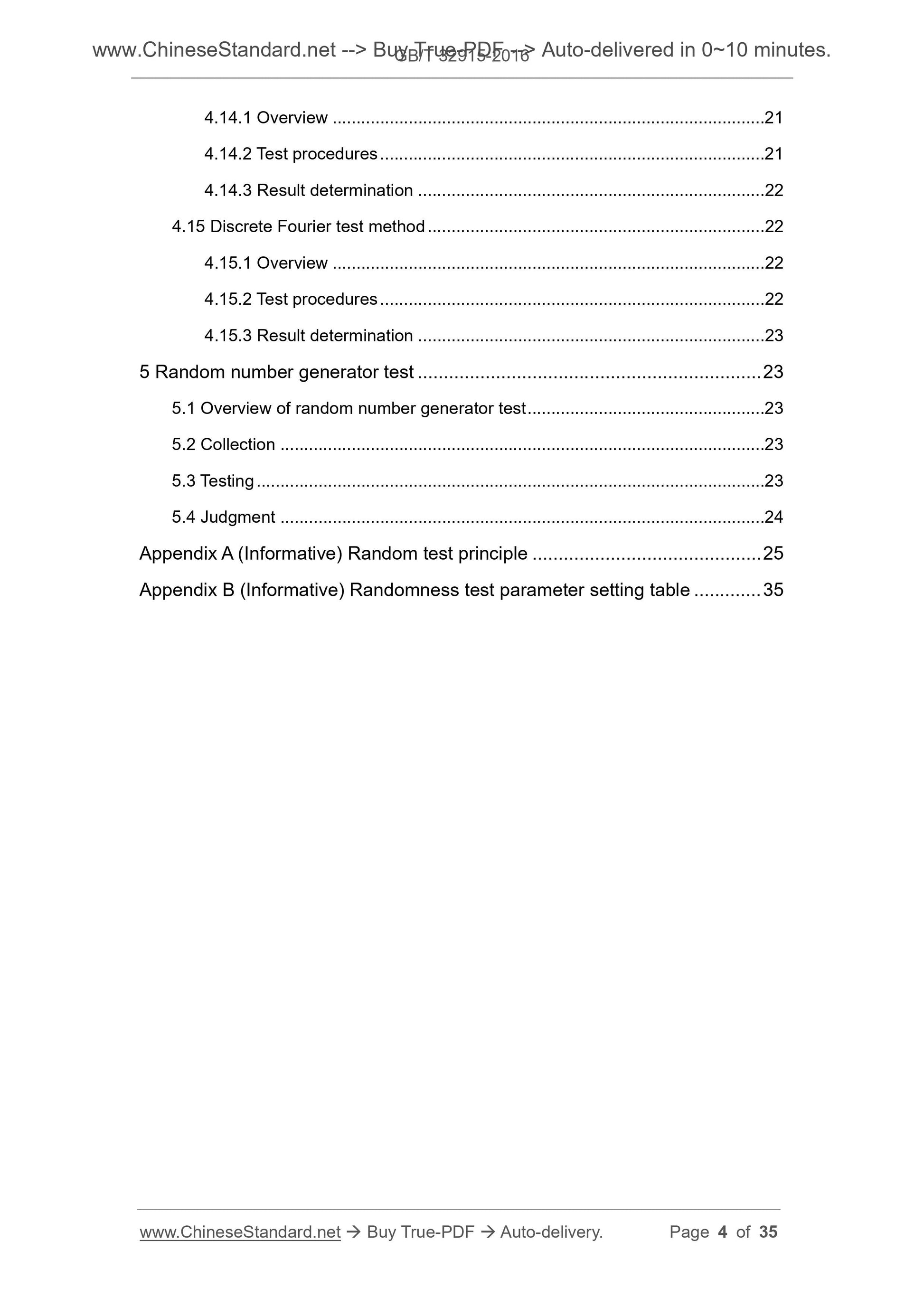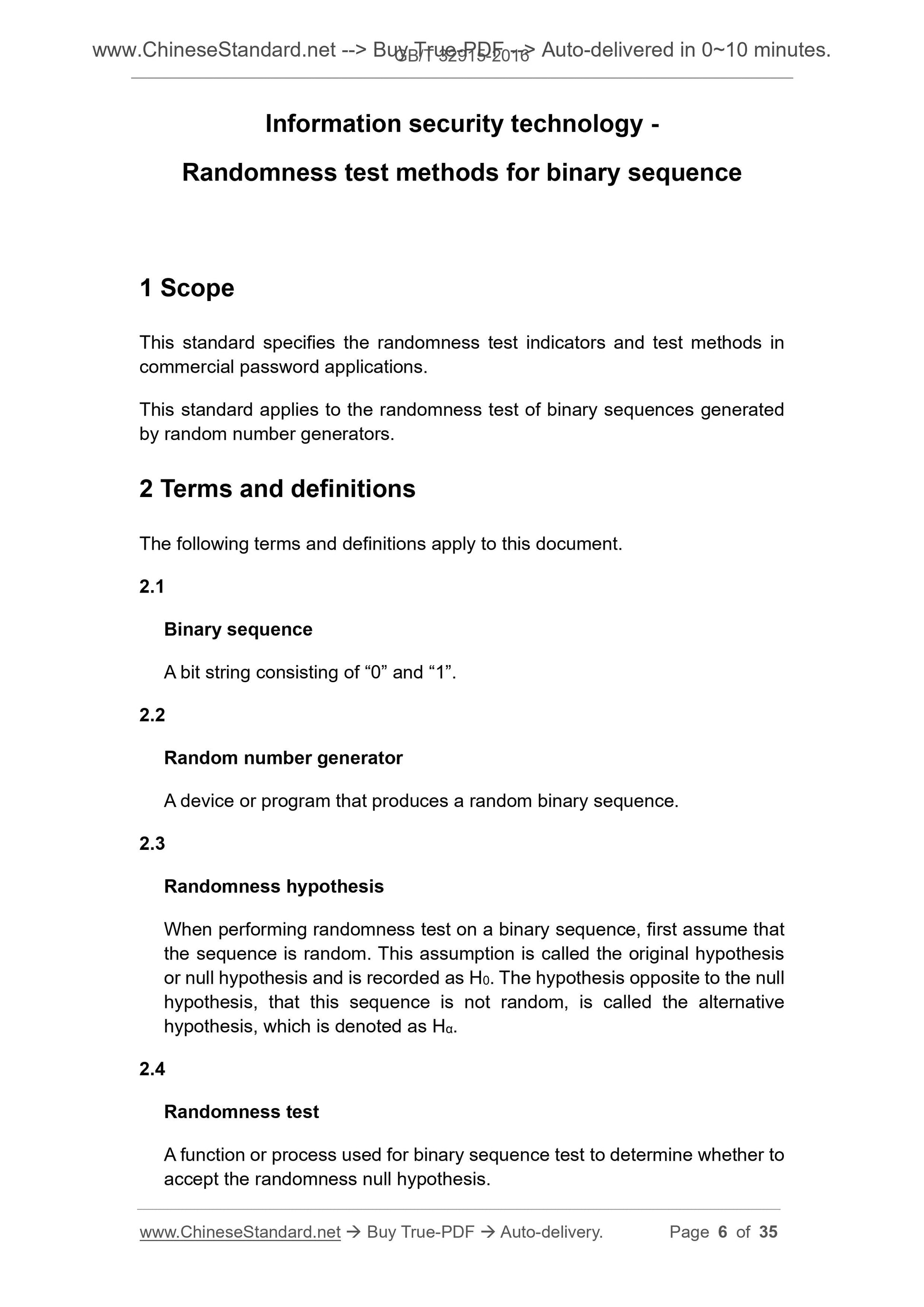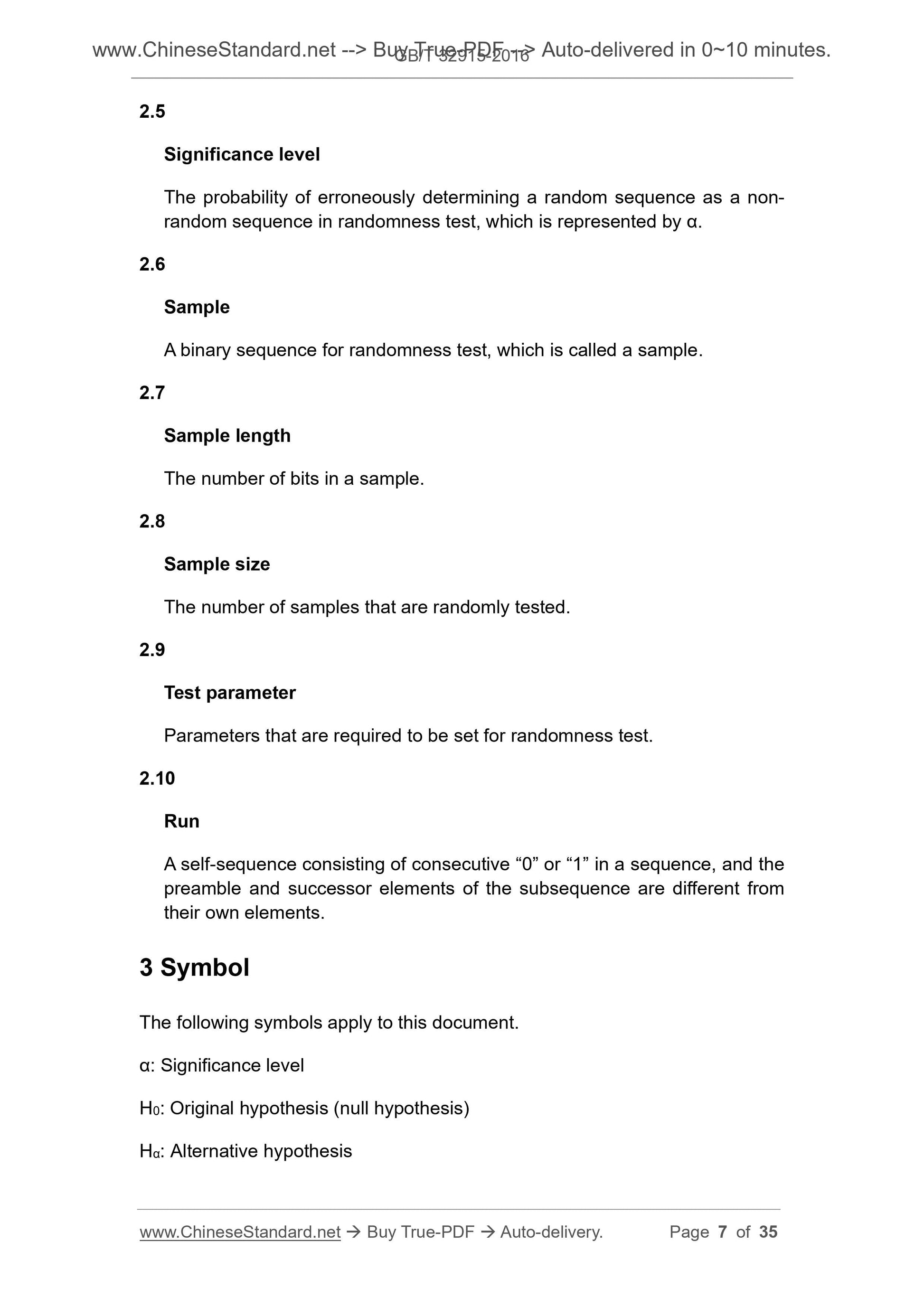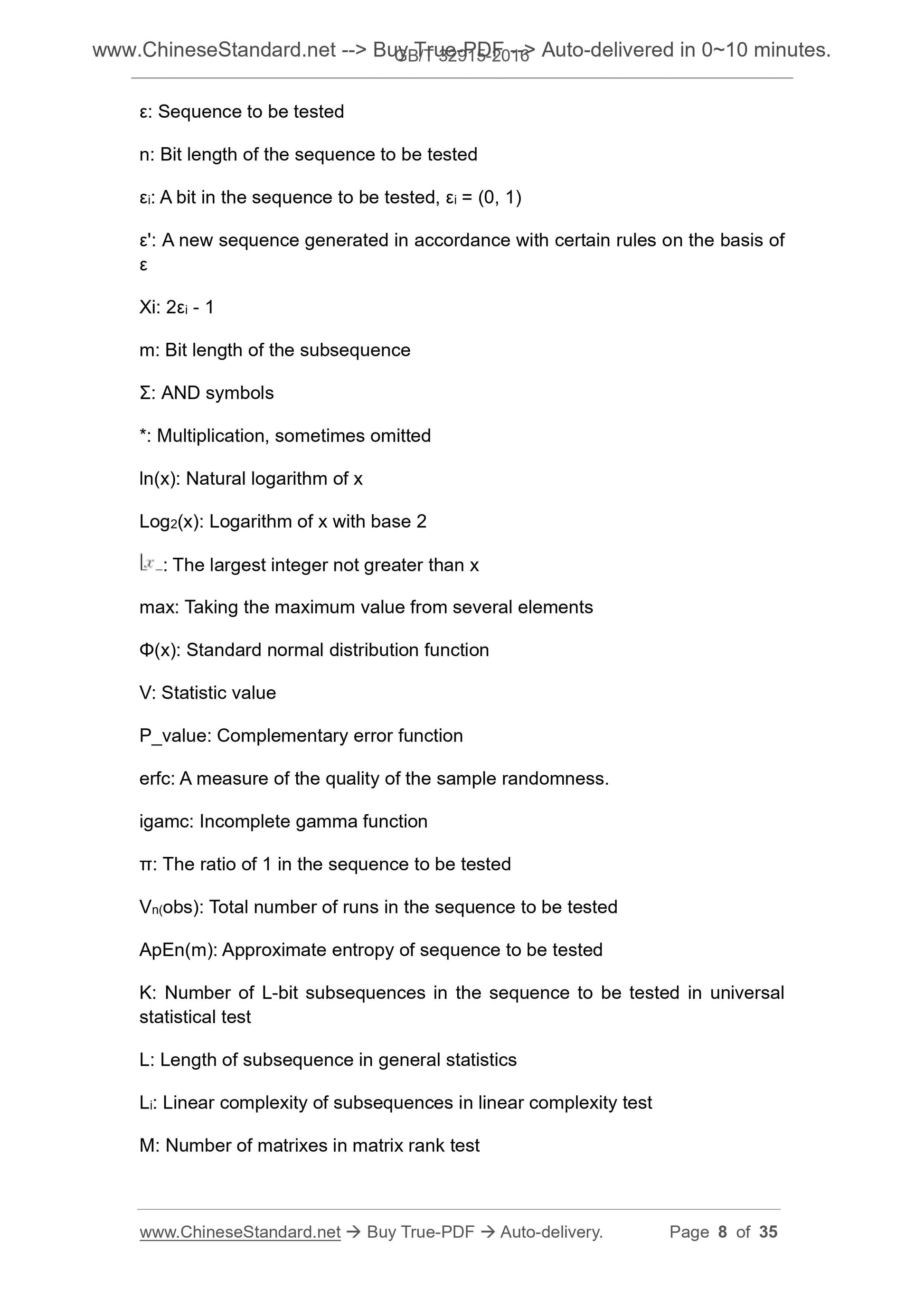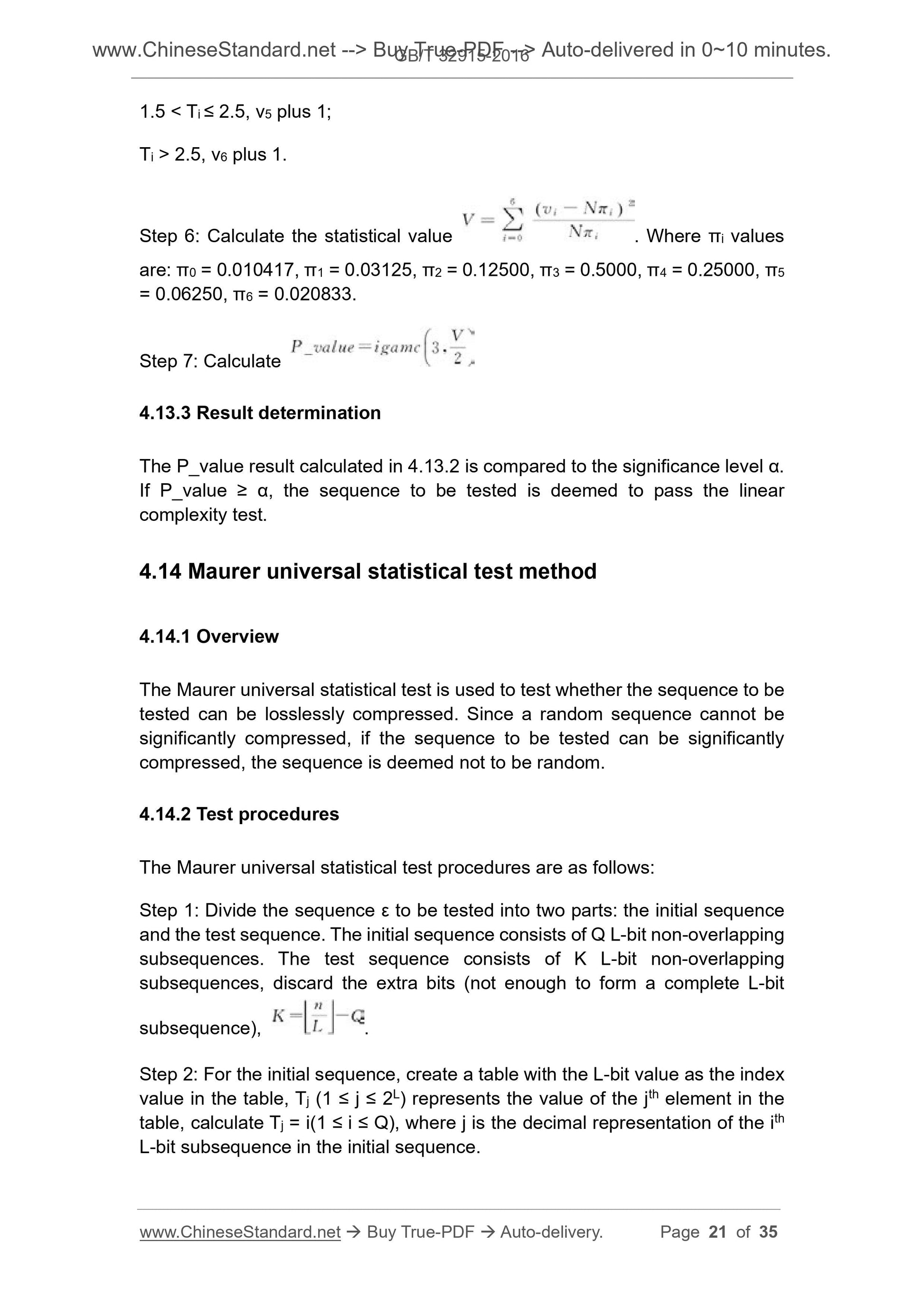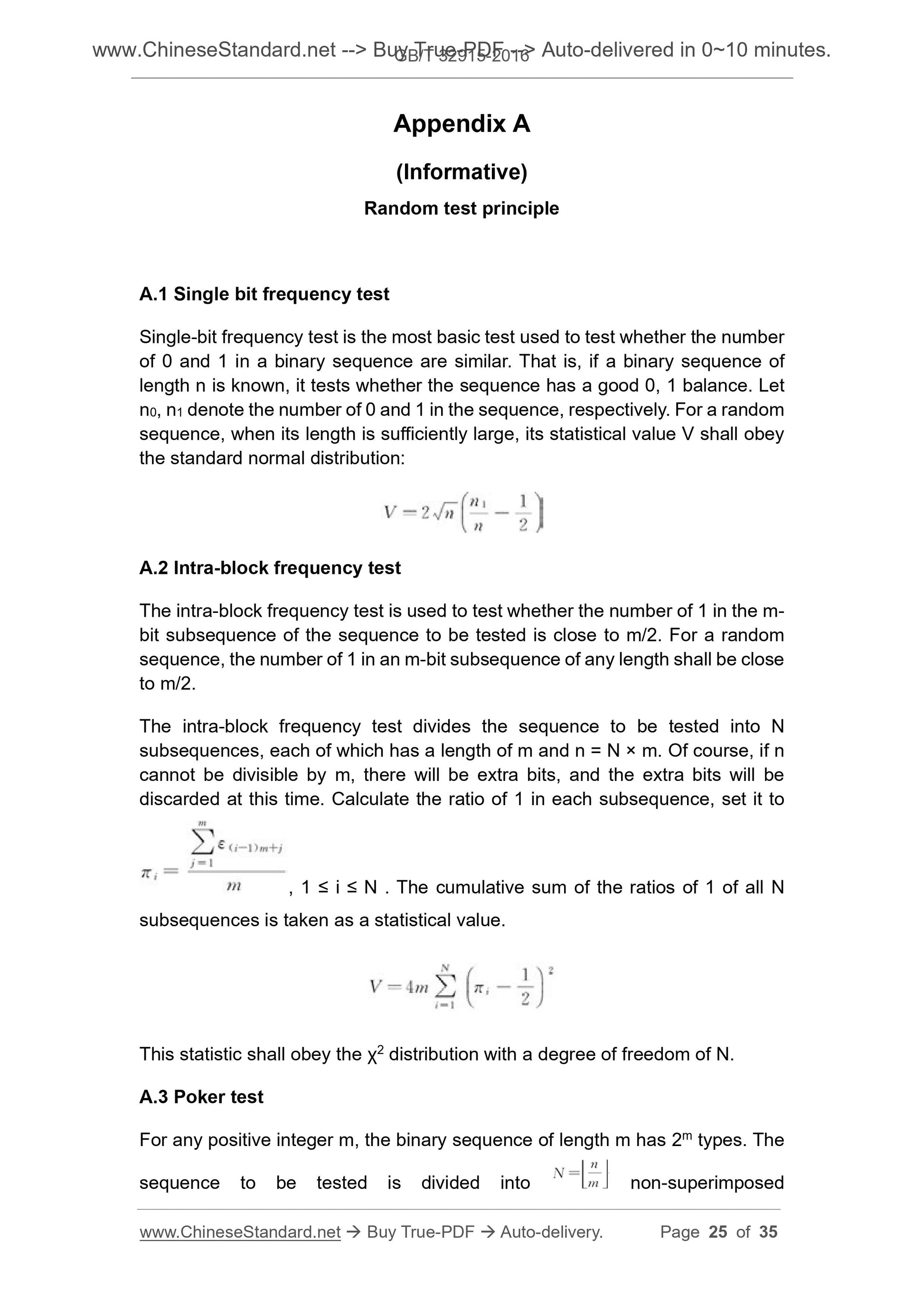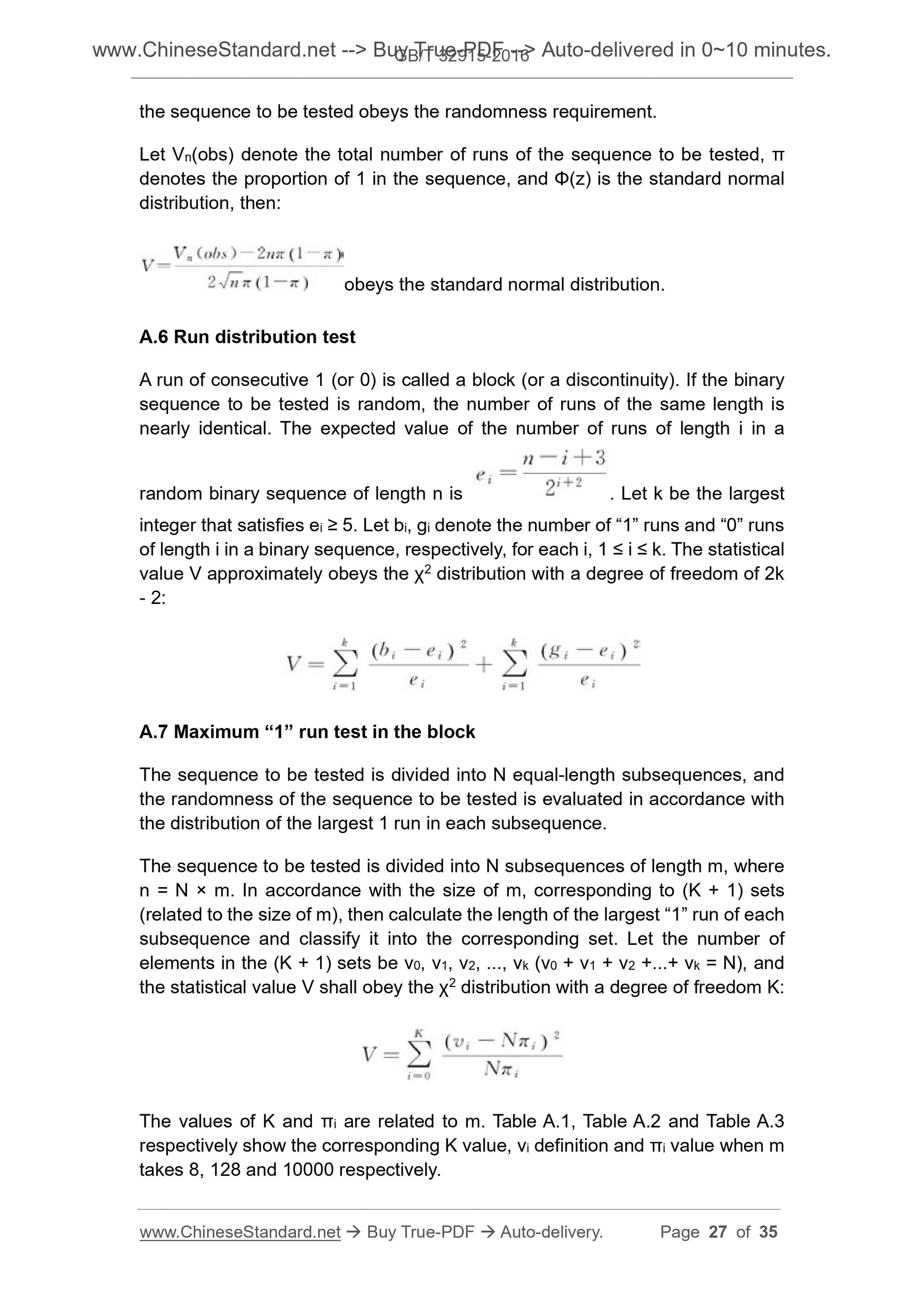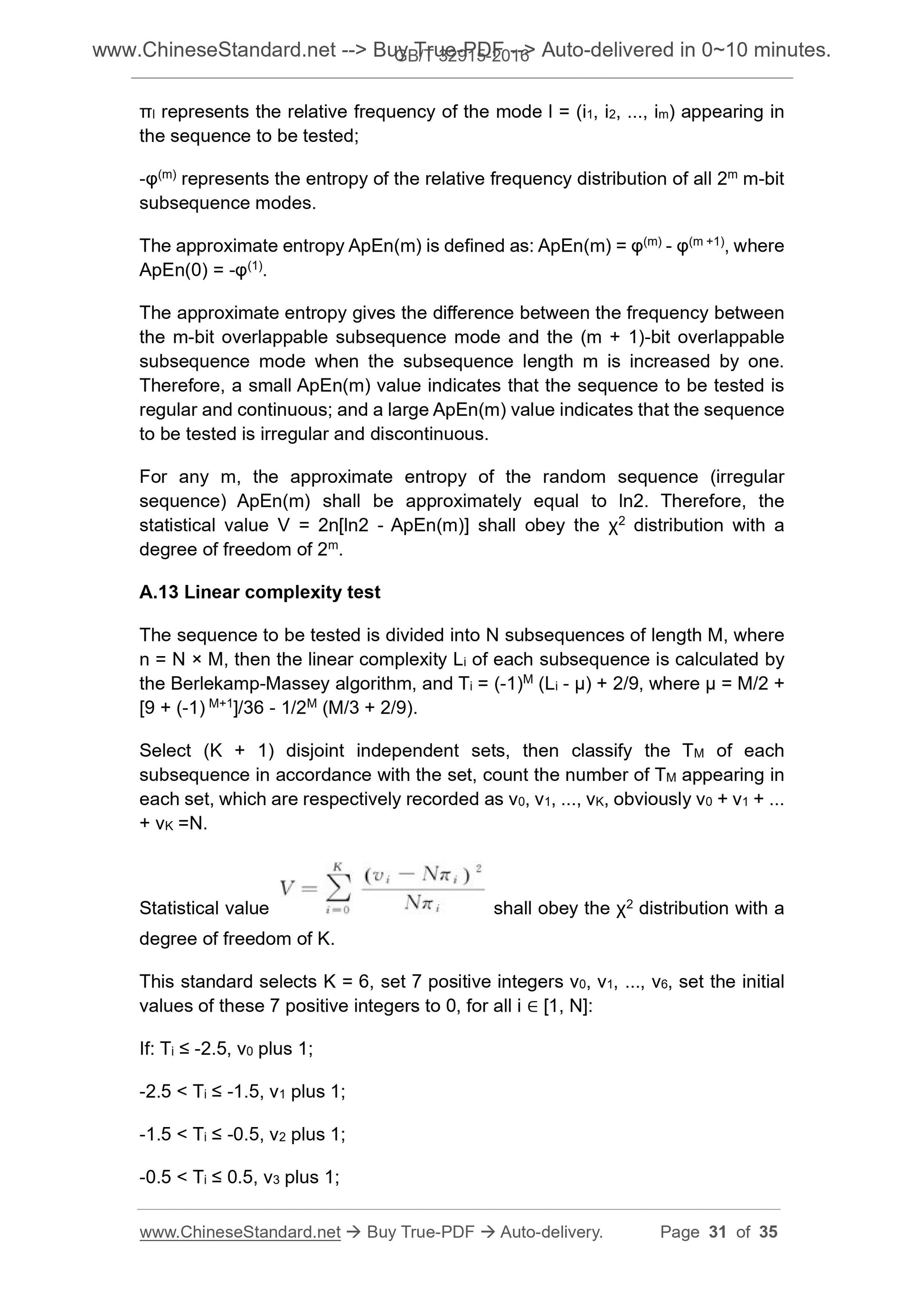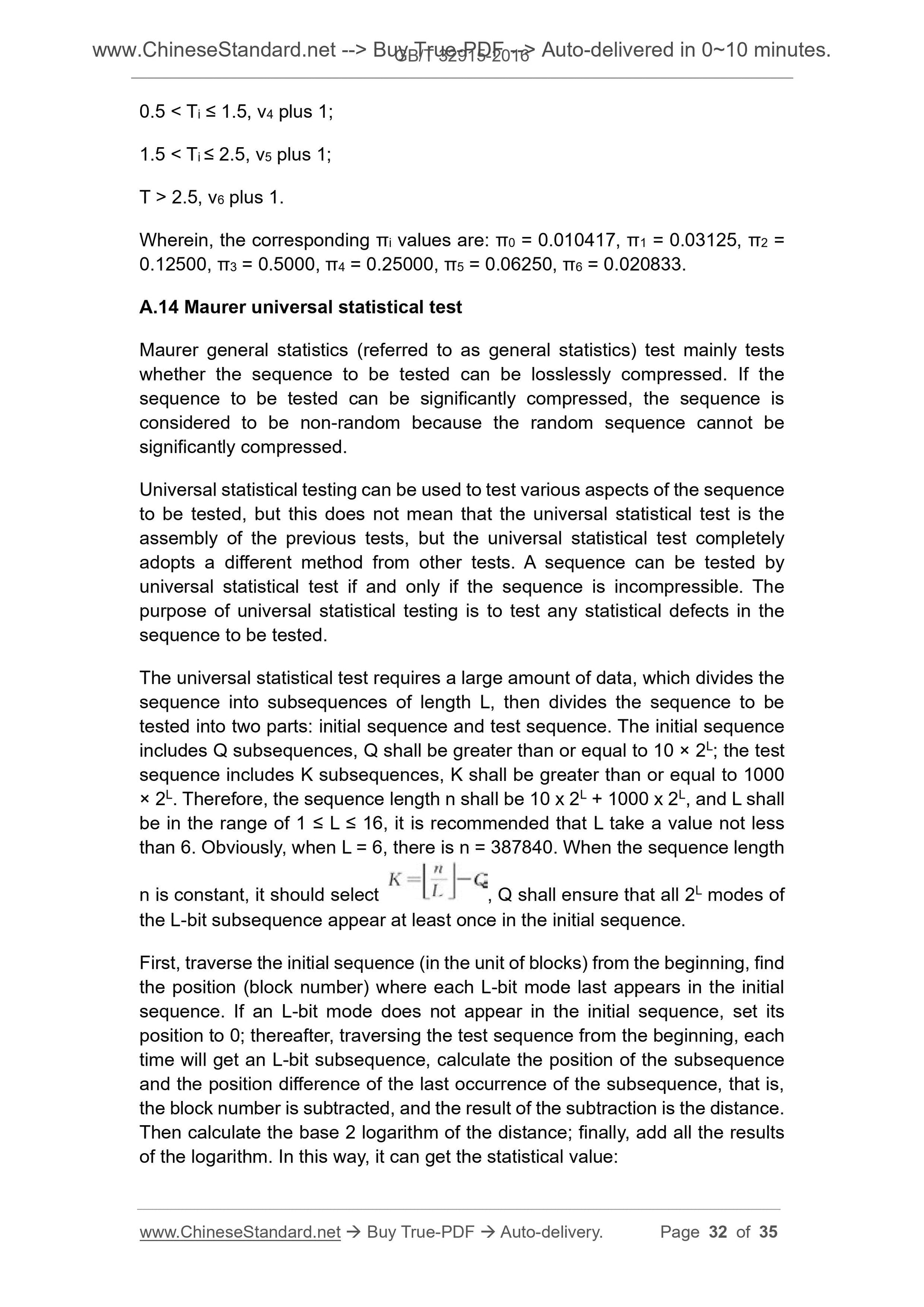1
/
of
12
PayPal, credit cards. Download editable-PDF and invoice in 1 second!
GB/T 32915-2016 English PDF (GB/T32915-2016)
GB/T 32915-2016 English PDF (GB/T32915-2016)
Regular price
$150.00 USD
Regular price
Sale price
$150.00 USD
Unit price
/
per
Shipping calculated at checkout.
Couldn't load pickup availability
Delivery: 3 seconds. Download true-PDF + Invoice.
Get QUOTATION in 1-minute: Click GB/T 32915-2016
Historical versions: GB/T 32915-2016
Preview True-PDF (Reload/Scroll if blank)
GB/T 32915-2016: Information security technology -- Randomness test methods for binary sequence
GB/T 32915-2016
GB
NATIONAL STANDARD OF THE
PEOPLE’S REPUBLIC OF CHINA
ICS 35.040
L 80
Information security technology -
Randomness test methods for binary sequence
ISSUED ON. AUGUST 29, 2016
IMPLEMENTED ON. MARCH 01, 2017
Issued by. General Administration of Quality Supervision Inspection and
Quarantine of PRC;
Standardization Administration of PRC.
Table of Contents
Foreword ... 5
1 Scope ... 6
2 Terms and definitions ... 6
3 Symbol ... 7
4 Randomness test ... 9
4.1 Single bit frequency test method ... 9
4.1.1 Overview ... 9
4.1.2 Test procedures ... 9
4.1.3 Result determination ... 10
4.2 Block internal frequency test method ... 10
4.2.1 Overview ... 10
4.2.2 Test procedures ... 10
4.2.3 Result determination ... 10
4.3 Poker test method ... 11
4.3.1 Overview ... 11
4.3.2 Test procedures ... 11
4.3.3 Result determination ... 11
4.4 Overlapping subsequence test method ... 11
4.4.1 Overview ... 11
4.4.2 Test procedures ... 12
4.4.3 Result determination ... 12
4.5 Total run number test method ... 13
4.5.1 Overview ... 13
4.5.2 Test procedures ... 13
4.5.3 Result determination ... 13
4.6 Run distribution test method ... 13
4.6.1 Overview ... 13
4.6.2 Test procedures ... 14
4.6.3 Result determination ... 14
4.7 Maximum “1” run test method in block ... 14
4.7.1 Overview ... 14
4.7.2 Test procedures ... 14
4.7.3 Result determination ... 15
4.8 Binary derivation test method ... 15
4.8.1 Overview ... 15
4.8.2 Test procedures ... 15
4.8.3 Result determination ... 16
4.9 Autocorrelation test method... 16
4.9.1 Overview ... 16
4.9.2 Test procedures ... 16
4.9.3 Result determination ... 17
4.10 Matrix rank test method ... 17
4.10.1 Overview ... 17
4.10.2 Test procedures ... 17
4.10.3 Result determination ... 18
4.11 Cumulative sum test methods ... 18
4.11.1 Overview ... 18
4.11.2 Test procedures ... 18
4.11.3 Result determination ... 18
4.12 Approximate entropy test method ... 19
4.12.1 Overview ... 19
4.12.2 Test procedures ... 19
4.12.3 Result determination ... 20
4.13 Linear complexity test method ... 20
4.13.1 Overview ... 20
4.13.2 Test procedures ... 20
4.13.3 Result determination ... 21
4.14 Maurer universal statistical test method ... 21
4.14.1 Overview ... 21
4.14.2 Test procedures ... 21
4.14.3 Result determination ... 22
4.15 Discrete Fourier test method ... 22
4.15.1 Overview ... 22
4.15.2 Test procedures ... 22
4.15.3 Result determination ... 23
5 Random number generator test ... 23
5.1 Overview of random number generator test ... 23
5.2 Collection ... 23
5.3 Testing ... 23
5.4 Judgment ... 24
Appendix A (Informative) Random test principle ... 25
Appendix B (Informative) Randomness test parameter setting table ... 35
Information security technology -
Randomness test methods for binary sequence
1 Scope
This standard specifies the randomness test indicators and test methods in
commercial password applications.
This standard applies to the randomness test of binary sequences generated
by random number generators.
2 Terms and definitions
The following terms and definitions apply to this document.
2.1
Binary sequence
A bit string consisting of “0” and “1”.
2.2
Random number generator
A device or program that produces a random binary sequence.
2.3
Randomness hypothesis
When performing randomness test on a binary sequence, first assume that
the sequence is random. This assumption is called the original hypothesis
or null hypothesis and is recorded as H0. The hypothesis opposite to the null
hypothesis, that this sequence is not random, is called the alternative
hypothesis, which is denoted as Hα.
2.4
Randomness test
A function or process used for binary sequence test to determine whether to
accept the randomness null hypothesis.
2.5
Significance level
The probability of erroneously determining a random sequence as a non-
random sequence in randomness test, which is represented by α.
2.6
Sample
A binary sequence for randomness test, which is called a sample.
2.7
Sample length
The number of bits in a sample.
2.8
Sample size
The number of samples that are randomly tested.
2.9
Test parameter
Parameters that are required to be set for randomness test.
2.10
Run
A self-sequence consisting of consecutive “0” or “1” in a sequence, and the
preamble and successor elements of the subsequence are different from
their own elements.
3 Symbol
The following symbols apply to this document.
α. Significance level
H0. Original hypothesis (null hypothesis)
Hα. Alternative hypothesis
ε. Sequence to be tested
n. Bit length of the sequence to be tested
εi. A bit in the sequence to be tested, εi = (0, 1)
ε'. A new sequence generated in accordance with certain rules on the basis of
Xi. 2εi - 1
m. Bit length of the subsequence
Σ. AND symbols
*. Multiplication, sometimes omitted
ln(x). Natural logarithm of x
Log2(x). Logarithm of x with base 2
. The largest integer not greater than x
max. Taking the maximum value from several elements
Φ(x). Standard normal distribution function
V. Statistic value
P_value. Complementary error function
erfc. A measure of the quality of the sample randomness.
igamc. Incomplete gamma function
π. The ratio of 1 in the sequence to be tested
Vn(obs). Total number of runs in the sequence to be tested
ApEn(m). Approximate entropy of sequence to be tested
K. Number of L-bit subsequences in the sequence to be tested in universal
statistical test
L. Length of subsequence in general statistics
Li. Linear complexity of subsequences in linear complexity test
M. Number of matrixes in matrix rank test
1.5 < Ti ≤ 2.5, v5 plus 1;
Ti > 2.5, v6 plus 1.
Step 6. Calculate the statistical value . Where πi values
are. π0 = 0.010417, π1 = 0.03125, π2 = 0.12500, π3 = 0.5000, π4 = 0.25000, π5
= 0.06250, π6 = 0.020833.
Step 7. Calculate
4.13.3 Result determination
The P_value result calculated in 4.13.2 is compared to the significance level α.
If P_value ≥ α, the sequence to be tested is deemed to pass the linear
complexity test.
4.14 Maurer universal statistical test method
4.14.1 Overview
The Maurer universal statistical test is used to test whether the sequence to be
tested can be losslessly compressed. Since a random sequence cannot be
significantly compressed, if the sequence to be tested can be significantly
compressed, the sequence is deemed not to be random.
4.14.2 Test procedures
The Maurer universal statistical test procedures are as follows.
Step 1. Divide the sequence ε to be tested into two parts. the initial sequence
and the test sequence. The initial sequence consists of Q L-bit non-overlapping
subsequences. The test sequence consists of K L-bit non-overlapping
subsequences, discard the extra bits (not enough to form a complete L-bit
subsequence), .
Step 2. For the initial sequence, create a table with the L-bit value as the index
value in the table, Tj (1 ≤ j ≤ 2L) represents the value of the jth element in the
table, calculate Tj = i(1 ≤ i ≤ Q), where j is the decimal representation of the ith
L-bit subsequence in the initial sequence.
Appendix A
(Inform...
Get QUOTATION in 1-minute: Click GB/T 32915-2016
Historical versions: GB/T 32915-2016
Preview True-PDF (Reload/Scroll if blank)
GB/T 32915-2016: Information security technology -- Randomness test methods for binary sequence
GB/T 32915-2016
GB
NATIONAL STANDARD OF THE
PEOPLE’S REPUBLIC OF CHINA
ICS 35.040
L 80
Information security technology -
Randomness test methods for binary sequence
ISSUED ON. AUGUST 29, 2016
IMPLEMENTED ON. MARCH 01, 2017
Issued by. General Administration of Quality Supervision Inspection and
Quarantine of PRC;
Standardization Administration of PRC.
Table of Contents
Foreword ... 5
1 Scope ... 6
2 Terms and definitions ... 6
3 Symbol ... 7
4 Randomness test ... 9
4.1 Single bit frequency test method ... 9
4.1.1 Overview ... 9
4.1.2 Test procedures ... 9
4.1.3 Result determination ... 10
4.2 Block internal frequency test method ... 10
4.2.1 Overview ... 10
4.2.2 Test procedures ... 10
4.2.3 Result determination ... 10
4.3 Poker test method ... 11
4.3.1 Overview ... 11
4.3.2 Test procedures ... 11
4.3.3 Result determination ... 11
4.4 Overlapping subsequence test method ... 11
4.4.1 Overview ... 11
4.4.2 Test procedures ... 12
4.4.3 Result determination ... 12
4.5 Total run number test method ... 13
4.5.1 Overview ... 13
4.5.2 Test procedures ... 13
4.5.3 Result determination ... 13
4.6 Run distribution test method ... 13
4.6.1 Overview ... 13
4.6.2 Test procedures ... 14
4.6.3 Result determination ... 14
4.7 Maximum “1” run test method in block ... 14
4.7.1 Overview ... 14
4.7.2 Test procedures ... 14
4.7.3 Result determination ... 15
4.8 Binary derivation test method ... 15
4.8.1 Overview ... 15
4.8.2 Test procedures ... 15
4.8.3 Result determination ... 16
4.9 Autocorrelation test method... 16
4.9.1 Overview ... 16
4.9.2 Test procedures ... 16
4.9.3 Result determination ... 17
4.10 Matrix rank test method ... 17
4.10.1 Overview ... 17
4.10.2 Test procedures ... 17
4.10.3 Result determination ... 18
4.11 Cumulative sum test methods ... 18
4.11.1 Overview ... 18
4.11.2 Test procedures ... 18
4.11.3 Result determination ... 18
4.12 Approximate entropy test method ... 19
4.12.1 Overview ... 19
4.12.2 Test procedures ... 19
4.12.3 Result determination ... 20
4.13 Linear complexity test method ... 20
4.13.1 Overview ... 20
4.13.2 Test procedures ... 20
4.13.3 Result determination ... 21
4.14 Maurer universal statistical test method ... 21
4.14.1 Overview ... 21
4.14.2 Test procedures ... 21
4.14.3 Result determination ... 22
4.15 Discrete Fourier test method ... 22
4.15.1 Overview ... 22
4.15.2 Test procedures ... 22
4.15.3 Result determination ... 23
5 Random number generator test ... 23
5.1 Overview of random number generator test ... 23
5.2 Collection ... 23
5.3 Testing ... 23
5.4 Judgment ... 24
Appendix A (Informative) Random test principle ... 25
Appendix B (Informative) Randomness test parameter setting table ... 35
Information security technology -
Randomness test methods for binary sequence
1 Scope
This standard specifies the randomness test indicators and test methods in
commercial password applications.
This standard applies to the randomness test of binary sequences generated
by random number generators.
2 Terms and definitions
The following terms and definitions apply to this document.
2.1
Binary sequence
A bit string consisting of “0” and “1”.
2.2
Random number generator
A device or program that produces a random binary sequence.
2.3
Randomness hypothesis
When performing randomness test on a binary sequence, first assume that
the sequence is random. This assumption is called the original hypothesis
or null hypothesis and is recorded as H0. The hypothesis opposite to the null
hypothesis, that this sequence is not random, is called the alternative
hypothesis, which is denoted as Hα.
2.4
Randomness test
A function or process used for binary sequence test to determine whether to
accept the randomness null hypothesis.
2.5
Significance level
The probability of erroneously determining a random sequence as a non-
random sequence in randomness test, which is represented by α.
2.6
Sample
A binary sequence for randomness test, which is called a sample.
2.7
Sample length
The number of bits in a sample.
2.8
Sample size
The number of samples that are randomly tested.
2.9
Test parameter
Parameters that are required to be set for randomness test.
2.10
Run
A self-sequence consisting of consecutive “0” or “1” in a sequence, and the
preamble and successor elements of the subsequence are different from
their own elements.
3 Symbol
The following symbols apply to this document.
α. Significance level
H0. Original hypothesis (null hypothesis)
Hα. Alternative hypothesis
ε. Sequence to be tested
n. Bit length of the sequence to be tested
εi. A bit in the sequence to be tested, εi = (0, 1)
ε'. A new sequence generated in accordance with certain rules on the basis of
Xi. 2εi - 1
m. Bit length of the subsequence
Σ. AND symbols
*. Multiplication, sometimes omitted
ln(x). Natural logarithm of x
Log2(x). Logarithm of x with base 2
. The largest integer not greater than x
max. Taking the maximum value from several elements
Φ(x). Standard normal distribution function
V. Statistic value
P_value. Complementary error function
erfc. A measure of the quality of the sample randomness.
igamc. Incomplete gamma function
π. The ratio of 1 in the sequence to be tested
Vn(obs). Total number of runs in the sequence to be tested
ApEn(m). Approximate entropy of sequence to be tested
K. Number of L-bit subsequences in the sequence to be tested in universal
statistical test
L. Length of subsequence in general statistics
Li. Linear complexity of subsequences in linear complexity test
M. Number of matrixes in matrix rank test
1.5 < Ti ≤ 2.5, v5 plus 1;
Ti > 2.5, v6 plus 1.
Step 6. Calculate the statistical value . Where πi values
are. π0 = 0.010417, π1 = 0.03125, π2 = 0.12500, π3 = 0.5000, π4 = 0.25000, π5
= 0.06250, π6 = 0.020833.
Step 7. Calculate
4.13.3 Result determination
The P_value result calculated in 4.13.2 is compared to the significance level α.
If P_value ≥ α, the sequence to be tested is deemed to pass the linear
complexity test.
4.14 Maurer universal statistical test method
4.14.1 Overview
The Maurer universal statistical test is used to test whether the sequence to be
tested can be losslessly compressed. Since a random sequence cannot be
significantly compressed, if the sequence to be tested can be significantly
compressed, the sequence is deemed not to be random.
4.14.2 Test procedures
The Maurer universal statistical test procedures are as follows.
Step 1. Divide the sequence ε to be tested into two parts. the initial sequence
and the test sequence. The initial sequence consists of Q L-bit non-overlapping
subsequences. The test sequence consists of K L-bit non-overlapping
subsequences, discard the extra bits (not enough to form a complete L-bit
subsequence), .
Step 2. For the initial sequence, create a table with the L-bit value as the index
value in the table, Tj (1 ≤ j ≤ 2L) represents the value of the jth element in the
table, calculate Tj = i(1 ≤ i ≤ Q), where j is the decimal representation of the ith
L-bit subsequence in the initial sequence.
Appendix A
(Inform...
Share
